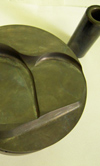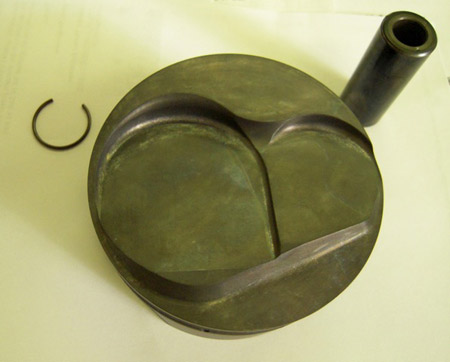Shaver's winning World of Outlaw pistons
 Shaver Engine Specialties of Torrance, California, is the official engine builder for Tony Stewart Racing's World of Outlaws sprint car team. Recently inducted into the Sprint Car Hall of Fame, Ron Shaver has a team of builders dedicated to producing 410 cu in engines for Stewart's cars, an enterprise that can take as long as 60 hours for a single engine.
Shaver Engine Specialties of Torrance, California, is the official engine builder for Tony Stewart Racing's World of Outlaws sprint car team. Recently inducted into the Sprint Car Hall of Fame, Ron Shaver has a team of builders dedicated to producing 410 cu in engines for Stewart's cars, an enterprise that can take as long as 60 hours for a single engine.
Shaver specifies a box-style piston made of 2618 alloy for these engines, and works with two piston manufacturers - one for standard orders and a second when he needs a quick turnround. While there was a time when he, as the engine builder, would designate the specifications of his pistons, that has changed over the years, and Shaver now relies on his suppliers. "They know exactly what we need and we don't have piston failures any longer," he says. "They improve every year."
His three-ring pistons are all phosphate-coated (a dry-film lubricant that helps with ring and pin break-in) and there are Teflon wear patches on the skirts. He uses two ring packages for these pistons and a horizontal gas porting: one set is 1.5 mm, 1.5 mm, 3 mm; the second pack Shaver has just started using is 0.043 in, 1.5 mm, 3 mm.
The pistons come out with each engine rebuild, which is scheduled after 550 race miles. "We usually rebuild at that time and always replace the pistons. Could they go further? Probably. They always pass crack tests but we just don't put them back in because it is a $1500 part, and if it ever failed our name would be mud," Shaver says.
Whenever he has a piston issue, he returns the part to the manufacturer and usually receives a clear response within eight hours - "Which is doggone good!"
Shaver has been using a 13º chamber, and there is squish on both sides as well as in the middle.
Being a slipper piston with a relatively short skirt, there is quite a lot of rock but it seems much more alarming when the piston is cold. In the hot, running engine it is a much closer fit, and getting the running fit just right is part of the development process.
The struts that come off the pin tower are common now in race pistons, and they provide the necessary stiffness and strength to the crown and ring lands in such a narrow slipper piston. They are an efficient use of material on a component where weight is so important.
Shaver acknowledges that skirt profile development "is kind of like voodoo. The cam profiles we use and the taper of the barrel - skirts are barrelled and not flared - is all done in CAD/CAM as to what's going to wear the best," he says. "In the old days we'd have all kinds of cam cuts but these days, with computers, they can put in anything they want, so we really don't press the manufacturers. We let them do what they think is best for the skirt."

For these sprint car engines Shaver doesn't specify any type of piston cooling. "They don't run long enough to get that kind of heat in them, and methanol keeps the piston temperatures much cooler. Because of that we don't need external cooling systems," he says. Were he to add extra cooling, the piston shapes and profiles would then have to be re-optimised.
His wrist pin is made of 9310 material with 0.120-0.200 in wall thickness. "They DLC-coat them," he says. "The wrist pin is a very important part of the piston. It's rigid and strong to help the piston with their strength. We use a round wire clip for pin retention without a tang on it."
When pistons arrive at Shaver's shop his staff check deck clearances and ring land clearances. They use a micrometer to make sure all dimensions are within spec, but until they come out of the engine, nothing additional is done.
"We always look at the wear and we look to see how they're doing, especially in the ring land area because of the different diameters. Our side ring groove clearances usually start out at a thousandth-and-a-half and the wear is crazy - sometimes they'll come back in at three or four thousandths wear because of the dirt ingested!"
Shaver doesn't really work on weight reduction for his pistons; he has two different compression heights, the standard piston weighs 430 g and the option weighs 455 g. "To a point we try to reduce weight but we're kind of stuck there because the loads we put on them - with the stroke and engine speed - the bottom of the piston has to hold on. We're getting past 10,000 lb of inertial load so we try to keep everything balanced with the piston speed - which is everything! When the piston speed goes past 5000 ft/min, you're in trouble," Shaver says.
He changes spec on the piston every year or so, but when he changes cylinder head specs - as he's about to do - he expects to change piston spec two or three times during development. "Usually we play in the ring area more than anything, trying to get a little more out of it. The top ring's ring location is what we really work on, but we're always chasing something."
Fig. 1 - Ron Shaver's piston valve pockets don't have a cut-out plunged pocket, as that would shroud the valves and hinder performance
Written by Anne Proffit